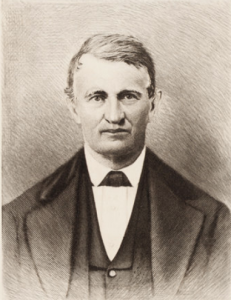(Nov. 6, 1786-Dec. 31, 1859). Born in Boundbrook, New Jersey, Blackford graduated from Princeton University. He read and practiced law in his home state until 1812 when he moved west, settling in Salem, Indiana. In Salem, he became the first Washington County clerk and recorder in 1813. He won the election for First Circuit Court judge in 1815 but resigned his term early to reenter private practice.
Governor Jonathan Jennings appointed Blackford to the Indiana Supreme Court in 1817, and he moved to Indianapolis soon after it became the capital. Only one session of the court had been held before he came to the bench and he remained a justice until 1852 when the position became an elected one (see ).
One of his most significant contributions as state Supreme Court justice was his . Published between 1830 and 1850, the eight-volume , shortened versions of most decisions made during his tenure, are the primary record for Supreme Court decisions of those years. Antebellum jurists and later scholars considered them to be model reports.
Blackford was a widower and considered a recluse. However, in addition to his duties on the court, he was an unsuccessful Whig candidate for the U.S. Senate in 1825 and served as president of the first state Common School Convention held in Indianapolis in 1847. He resumed his private practice in 1853. Two years later, President Franklin Pierce appointed him judge of the U.S. Court of Claims in Washington, D.C. Following his death, Blackford’s body was returned to Indianapolis for burial. In 1868 his grave was moved to .
In 2011, the erected a state historical marker for Blackford on the northeast corner of Blackford and New York streets.

Help improve this entry
Contribute information, offer corrections, suggest images.
You can also recommend new entries related to this topic.





